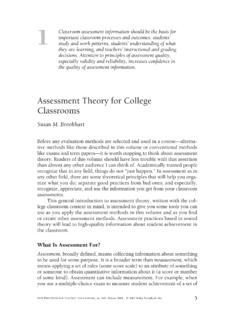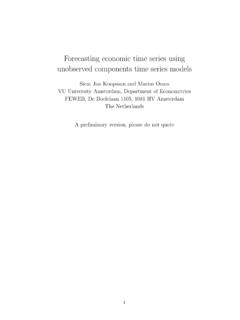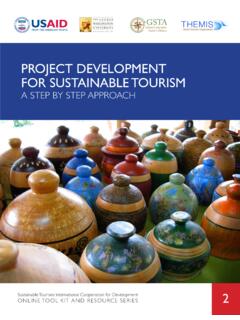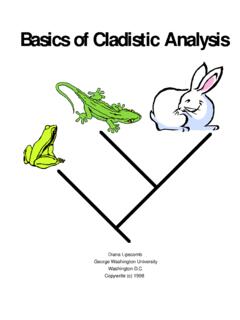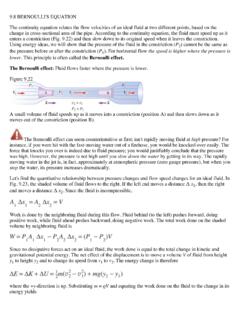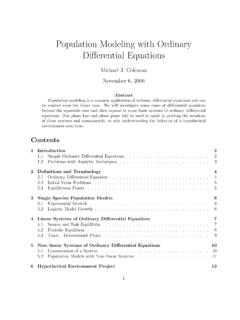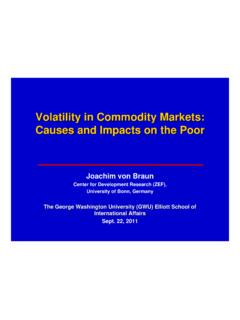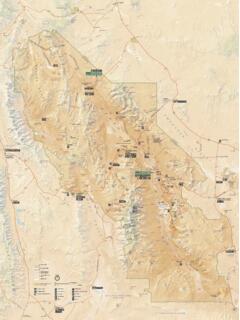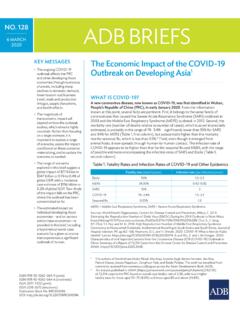Transcription of The Economic Impact of the Black Death
1 Institute for International Economic Policy Working Paper Series Elliott School of International Affairs The George Washington University The Economic Impact of the Black Death IIEP-WP-2020-14 Remi Jedwab George Washington University Noel D. Johnson George Mason University Mark Koyama George Mason University August 2020 Institute for International Economic Policy 1957 E St. NW, Suite 502 Voice: (202) 994-5320 Fax: (202) 994-5477 Email: Web: The Economic Impact of the Black DeathRemi Jedwab and Noel D. Johnson and Mark Koyama*August 4, 2020 AbstractThe Black Death was the largest demographic shock in European history. Wereview the evidence for the origins, spread, and mortality of the that it was a plausibly exogenous shock to the European economy andtrace out its aggregate and local impacts in both the short-run and the initial effect of the plague was highly disruptive.
2 Wages and per capita incomerose. But, in the long-run, this rise was only sustained in some parts of Europe. Theother indirect long-run effects of the Black Death are associated with the growthof Europe relative to the rest of the world, especially Asia and the Middle East(the Great Divergence), a shift in the Economic geography of Europe towards theNorthwest (the Little Divergence), the demise of serfdom in Western Europe, adecline in the authority of religious institutions, and the emergence of strongerstates. Finally, avenues for future research are laid Codes: N00; N13; I15; I14; J11; O10; O43 Keywords: Pandemics; Black Death ; Institutions; Cities; Urbanization; MalthusianTheory; Demography; Long-Run Growth; Middle Ages; Europe; Asia*Corresponding author:Mark Koyama:Department of Economics, George Mason University and Noel Johnson: Department of Economics, George Mason University, Jedwab: Department of Economics, George Washington University, We would like to thankCarlos Alvarez-Nogal, Leandro Prados de la Escosura, and Carlos Santiago-Caballero for sharing data on Spain.
3 Weare grateful to Guido Alfani, Mark Bailey, Brian Beach and Klaus Prettner for helpful Economic Impact OF THE Black DEATH1In October 1347 ships arrived in the Sicilian port of Messina carrying Genoese merchantsfrom the Crimean Port of Kaffa. In addition to their cargoes, they carried a deadly new the next five years, what would come to be known as the Black Death , spread across Europeand the Middle East killing between 30% and 50% of the McNeil (1974) historians have increasingly recognized that the fates of premoderneconomies were shaped by environmental shocks, the most important of which was epidemicdisease. Disease is implicated in the fall of the Roman Empire (Harper, 2017) and in the GoldenAge of Islam between 630-850 CE (Pamuk and Shatzmiller, 2014).
4 The spread of disease alsomade possible the European conquest of the Americas (Mann, 2011).The Black Death has long been viewed as a watershed in European history and is the subjectof a vast scholarly literature. Historians, epidemiologists, demographers, and economists haveall contributed to the study of its origins, spread, and Economic history,numerous scholars have traced the origins of the Great Divergence between Europe and therest of the world to the Black Death (North and Thomas, 1973; Gottfried, 1983; Herlihy, 1997;Epstein, 2000; Pamuk, 2007; Acemoglu and Robinson, 2012; Frankopan, 2015; Campbell, 2016).Some also see it as the initiator of the so-called Little Divergence which set Northwestern Europeand Southern Europe on different growth paths by 1500 (Allen, 2001; Pamuk, 2007; van Zanden,2009a; de Pleijt and van Zanden, 2013; Voigtl ander and Voth, 2013b,a).
5 Studying the Black Death yields insights into present-day public health issues as well aseconomic history. It was, in proportional terms, the deadliest epidemic shock in history. It wasalso a comparatively pure demographic shock: It only killed people physical capital ( ,equipment, buildings and infrastructure) and natural capital ( , land, livestock and naturalresources) were left untouched. There was also no government aid in the wake of the diseasemitigating its Impact . Finally, as we will discuss below, variation in mortality rates from theplague were largely random. These facts have allowed researchers to use the plague as a probeto study the Impact of negative demographic shocks on subjects as varied as political change,the persecution of minorities, urban growth, and Economic development more scholars have interpreted the Black Death through the lens of a Malthusian framework( Postan, 1959; Postan et al.)
6 , eds, 1963; Hatcher and Bailey, 2001; Clark, 2007). The Malthusianmodel can be interpreted as the first stage in a unified growth model as developed by Galorand Weil (1999, 2000) and Galor (2011). According to unified growth theory, when the stock ofhuman capital and the underlying rate of technological change are both low, an increase in percapita income induces a positive fertility response. The resulting population growth will, dueto diminishing returns, cause per capita income to fall. This is the canonical Malthusian Trap .2 REMI JEDWAB, NOEL D. JOHNSON AND MARK KOYAMAAs Ashraf and Galor (2011) frame it, most preindustrial economies can be described as broadlyMalthusian in the following sense: (i) in the cross-section, there was no association betweenland productivity and per capita income but there was a positive association between landproductivity and population density; (ii) over time per capita income growth and populationgrowth were negatively correlated; and (iii) there was no tendency for per capita income torise over time or with technological progress.
7 This Malthusian framework remains relevant fordeveloping countries today (Weil and Wilde, 2009; Jedwab and Vollrath, 2019).The Black Death provides an opportunity to test the Malthusian model. One can ask: Whathappened to real wages, incomes, and interest rates after Europe s population collapsed byabout 40 percent? A common view interprets the Black Death as confirming the predictionsof the basic Malthusian model (Clark, 2007), though as we will see, the evidence is have interpreted the Black Death using a Smithian framework. According to thisview, Economic development is driven by a deepening of the division of labor, specialization,and commercialization suggesting a positive, not negative, relationship between populationgrowth and Economic growth (Boserup, 1965; Grantham, 1999; Hatcher and Bailey, 2001;Broadberry et al.)
8 , 2015). As Broadberry et al. (2015, 271) describe it: Under conditions ofSmithian growth, higher population densities expand the size of the market, increase thepotential for greater division of labour and lead, via a series of positive-feedback mechanisms,to the establishment of a gradually ascending spiral of progress .Under the Smithianinterpretation, then, the Black Death damaged the European economy by reducing populationand market size and preventing specialization and what can be broadly described as an institutional perspective, other scholars haveargued that the plague changed the configuration ofde factoeconomic power and disruptedpolitical equilibria (Epstein, 2000; Cohn, 2003, 2010; Acemoglu and Robinson, 2012).
9 Thisinstitutional perspective reflects the convergence of several distinct lines of scholarly with overly demographic Malthusian interpretations described above, andassociated with Postan (1959) and Postan et al., eds (1963), led Marxist historians in the1970s to consider issues of institutional power (for example, Brenner, 1976; Bois, 1976, 2009).Concurrently, Douglass North and coauthors used the Black Death as one of the earlier casestudies of institutional change induced through relative price movements (North and Thomas,1973; North, 1981, 1990). From this perspective, the dramatic change in the relative price of laborto land caused by the Black Death generated institutional changes that were critical in the rise ofwestern Europe. More recently, scholars influenced by developments in institutional economicshave built on these insights in a range of directions (Haddock and Kiesling, 2002; Robinson andTHE Economic Impact OF THE Black DEATH3 Torvik, 2011; Acemoglu and Robinson, 2012).
10 Similarly, researchers have devoted attention tohow long-run inequality changed following the Black Death (Scheidel, 2017; Alfani, 2020).In what follows, we survey the Economic Impact of the Black Death . In Section 1., we reviewthe epidemiology and spread of the plague. In Section 2., we examine how it affected economiesin the short run. In Section 3., we consider the long-run implications of the direct economicimpact of the plague, including on living standards and on urban and rural areas. In Section4., we broaden our analysis to consider the indirect impacts of the plague in the long-run onfertility, labor markets, institutions, and religion. Section 5. lays out avenues for future The Origins of the Black The Epidemiology ofYersinia PestisThe disease referred to by 14th century chroniclers as the Black Death , Black Plague, or the GreatMortality was largely a mystery to them.
